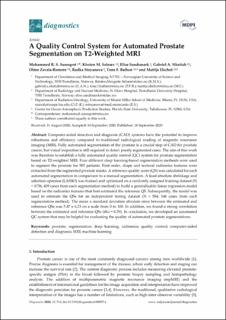| dc.contributor.author | Sunoqrot, Mohammed R. S. | |
| dc.contributor.author | Selnæs, Kirsten Margrete | |
| dc.contributor.author | Sandsmark, Elise | |
| dc.contributor.author | Nketiah, Gabriel Addio | |
| dc.contributor.author | Zavala-Romero, Olmo | |
| dc.contributor.author | Stoyanova, Radka | |
| dc.contributor.author | Bathen, Tone Frost | |
| dc.contributor.author | Elschot, Mattijs | |
| dc.date.accessioned | 2020-09-25T11:20:37Z | |
| dc.date.available | 2020-09-25T11:20:37Z | |
| dc.date.created | 2020-09-18T15:11:39Z | |
| dc.date.issued | 2020 | |
| dc.identifier.issn | 2075-4418 | |
| dc.identifier.uri | https://hdl.handle.net/11250/2679703 | |
| dc.description.abstract | Computer-aided detection and diagnosis (CAD) systems have the potential to improve robustness and efficiency compared to traditional radiological reading of magnetic resonance imaging (MRI). Fully automated segmentation of the prostate is a crucial step of CAD for prostate cancer, but visual inspection is still required to detect poorly segmented cases. The aim of this work was therefore to establish a fully automated quality control (QC) system for prostate segmentation based on T2-weighted MRI. Four different deep learning-based segmentation methods were used to segment the prostate for 585 patients. First order, shape and textural radiomics features were extracted from the segmented prostate masks. A reference quality score (QS) was calculated for each automated segmentation in comparison to a manual segmentation. A least absolute shrinkage and selection operator (LASSO) was trained and optimized on a randomly assigned training dataset (N = 1756, 439 cases from each segmentation method) to build a generalizable linear regression model based on the radiomics features that best estimated the reference QS. Subsequently, the model was used to estimate the QSs for an independent testing dataset (N = 584, 146 cases from each segmentation method). The mean ± standard deviation absolute error between the estimated and reference QSs was 5.47 ± 6.33 on a scale from 0 to 100. In addition, we found a strong correlation between the estimated and reference QSs (rho = 0.70). In conclusion, we developed an automated QC system that may be helpful for evaluating the quality of automated prostate segmentations. | en_US |
| dc.language.iso | eng | en_US |
| dc.publisher | MDPI | en_US |
| dc.rights | Navngivelse 4.0 Internasjonal | * |
| dc.rights.uri | http://creativecommons.org/licenses/by/4.0/deed.no | * |
| dc.title | A Quality Control System for Automated Prostate Segmentation on T2-Weighted MRI | en_US |
| dc.type | Journal article | en_US |
| dc.type | Peer reviewed | en_US |
| dc.description.version | publishedVersion | en_US |
| dc.source.volume | 10 | en_US |
| dc.source.journal | Diagnostics (Basel) | en_US |
| dc.source.issue | 9 | en_US |
| dc.identifier.doi | https://doi.org/10.3390/diagnostics10090714 | |
| dc.identifier.cristin | 1831243 | |
| dc.description.localcode | © 2020 by the authors. Licensee MDPI, Basel, Switzerland. This article is an open access article distributed under the terms and conditions of the Creative Commons Attribution (CC BY) license (http://creativecommons.org/licenses/by/4.0/). | en_US |
| cristin.ispublished | true | |
| cristin.fulltext | original | |
| cristin.qualitycode | 1 | |

